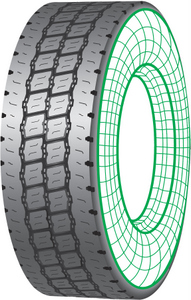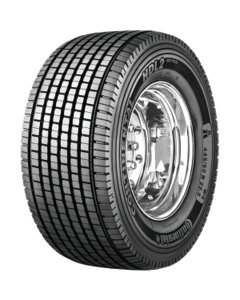Regardless of the retread you select, the process rests on the quality of the tire casing. It takes a quality casing to produce a quality retread. Every aspect of the new tire building process impacts casing quality, including the tire building process, grade of materials selected, engineering modeling, tire design and the tire’s dimensional specifications.

“Fleet managers, today, have multiple resources for evaluating casing retreadability. The latest generation non-destructive testing equipment allows us to look inside the casing for objective evaluation,” said Patrick Gunn, director of sales and marketing, commercial tires, for Giti Tire (USA) Ltd., which markets and sells GT Radial commercial tires in North America. “Regardless of the retread process and brand that a fleet selects, they can utilize a database to determine the casing inspection rejection rates of different casings by brand, wheel position and application. This can serve as an initial indicator for casing quality assessment.”
When retreading, one of the biggest casing quality concern when retreading a tire is for sure the belt separation. Most of the time it’s hidden into the belt package and cannot be detected during a visual and tactile inspection.
“Top quality retreaders will not retread a tire that does not pass very careful inspections [such as shearography and non-destructive testing] to be certain that the casing is suitable for another successful life,” said Harvey Brodsky, managing director of the Retread Tire Association.
Many retreaders, such as Marangoni, use a Shearography inspection machine to detect any belt separation.
While Goodyear does not mandate the use of shearography when it comes to tire inspection, it does offer shearography equipment for its Goodyear Authorized Retreader Network. Goodyear’s Commercial Tire and Service Centers retread facilities use electronic discharge devices instead of shearography to find nail-hole casing penetrations that can be difficult to detect visually. “We also use a multi-level pressure system to detect weak or broken cords in the upper sidewalls of casings that have not been detectable via other inspection methods such as x-ray,” explained Todd Labbe, general manager, commercial retreads, The Goodyear Tire & Rubber Co.
Maintaining correct inflation pressure is the single most important practice that a fleet can employ to help maintain casing integrity. Underinflation causes tires to flex as they roll down the highway. This results in internal heat build-up. Excessive heat can cause a tire’s components to deteriorate, which can compromise casing integrity. Incorrect inflation also can hurt fuel economy since underinflated tires force truck engines to work harder.
“We recommend that fleets check inflation pressures at least once a week. Keeping trucks properly aligned is another important practice,” Labbe said. “Over time, a regular alignment program can boost tire mileage and reduce the occurrence of irregular tire wear.”
Other than inflation, the tire history plays a large role in the quality of the casing. Matt Schnedler, retread product marketing manager, Bridgestone Commercial Solutions, explained that overloading, explained that not pulling at the proper depth and misapplication (in addition to underinflation) are tire aspects that will severely limit the useful life of the casing.
Additionally, it’s important to keep the vehicles properly aligned and replace the suspension parts when they are worn. Some fleets also include tire/retread rotations as part of their maintenance practice.
“Fleets should always have a good written maintenance policy in place … This policy should cover the casings, number of times a quality casing will be retreaded based on the vehicle usage, casing age and condition, tire position, type and quality of the new retreads,” agreed said Paul Crehan, director of product marketing, Michelin Truck Tires. “In most instances, a fleet rarely purchases casings to retread them but rather utilizes the casing assets it already has in its fleet. This asset value is then not part of the cost equation of a retread.”
Self-sealing solutions
Fleets that run self-sealing tire solutions, such as Goodyear’s DuraSeal Technology, which is the only built-in self-sealing technology in the industry, can rest assured that retreading is still a viable option for these tires. Goodyear’s Todd Labbe explains: “Thousands of Goodyear DuraSeal truck tires have been successfully repaired and retreaded since Goodyear introduced DuraSeal Technology in 2006. In fact, DuraSeal’s bright yellow color makes it easier for retreaders to detect punctures in the casing’s tread area during the casing inspection process.” Retreaders should follow the guidelines of the new tire and retread suppliers to ensure proper retreading procedures are followed. Self sealing casings follow the same guidelines as non-self-sealing casings. However, if a self-sealing tire is damaged, then that can require a slightly different retread process to ensure that the damage is repaired properly. Additionally, if the self-sealing feature includes uncured rubber, care must be taken to avoid contamination with other tires/retreads. The retreader must follow the guidelines of the new tire and retread suppliers.

Going wide
Wide-base tires are gaining traction in fleets for due to their promise of increased efficiency and additional payload transportation. With such tire success comes retreading solutions. Wide-base tires can be effectively retreaded to offer additional cost savings and lower the total cost of ownership for this asset. Like other retread offerings, retreaders claim that wide-base retreads offer similar fuel efficiency and performance as new tires, as long as the proper buff radius is applied.
Proper pull points
The establishment of a proper pull point for retreading will ensure that you are keeping your tires in service as long as you can without jeopardizing casing damage and retreadability. This will help generate lower cost per mile operation and tire program efficiency. So when is the proper time to pull a tire for retreading?
“According to the Tire Retread & Repair Information Bureau, the only hard and fast rule is mandated by the government—all fleets are required to pull steer tires when they reach 4/32nds remaining tread depth, while the limit for drive and trailer tires is 2/32nds,” said Patrick Gunn, Director of Sales and Marketing, Commercial Tires, for Giti Tire (USA) Ltd. “While some fleets are concerned about retreading too late, we have noticed that some fleets are retreading too soon because their drivers are worried that the treads don’t appear as aggressive as they did when new, a particular concern with winter approaching. Rather than shipping the drive tires to a retreader with usable tread still on them, one great option is to move the partially worn drive tires to the trailer position. A thorough, ongoing tire evaluation program and consultation with your retreader will help you determine the sweet spot for pulling your tires for retreading.”














